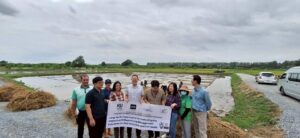
What does it take to attain global food security? This is a question for which rice provides part, if not most, of the answer. Rice—a staple food for the world’s poor—is grown on more than 155 million hectares and accounts for one-fifth of the global calorie supply. In the past decade, changes such as rapid economic growth, especially in parts of Asia, rising wage rates, increasing diversification of diets, global climate change, and a greater integration of the food economy with other sectors of the global economy, including both energy and financial markets, have converged to shape the way rice is produced today and will be produced in the future.
Faced with more challenges in the years ahead, the world now needs a new vision for future rice farming to position investments in rice research, technology delivery, and designs for policy reforms strategically. Food security has risen in prominence on global leaders’ agenda as the food crisis of 2008 rocked not just the market but also social stability, and, recently, there has been a rising concern that history will repeat itself.
Such a vision has been developed in a new book, Rice in the Global Economy: Strategic Research and Policy Issues for Food Security, published by IRRI in 2010 to commemorate its 50th anniversary. This edited volume, which consists of 18 chapters co-authored by 59 experts, was officially released in November 2010 during the International Rice Congress held in Hanoi, Vietnam.
The book is forward-looking and various scholarly contributions lay out a rich menu of options for enhancing the overall performance of the global rice economy to reduce poverty and hunger.
As outlined in the book, five major challenges confront scientists and policymakers: meeting global food security needs by providing an affordable and stable supply of rice, managing structural change successfully, enhancing efficiency in input use and value chains, reducing environmental footprints, and improving productivity in the lagging regions such as Africa.

Challenges to attaining sustainable food security
A major challenge is sustaining the global rice supply to meet rising consumption demand up until 2025 and beyond. Even if total consumption decreases somewhat beyond 2025 due to increasing dietary diversification, yield increases must be sustained to make up for the area lost to other crops as agriculture becomes more diversified and, most importantly, to cope with the negative impacts of climate change.
It is also equally important to manage price volatility for global and national food security—a necessary strategy in the face of increasingly frequent and severe shocks caused by water scarcity, higher energy prices, and climate change.
Asian agriculture is poised to undergo major structural changes as nonagricultural sectors expand with economic growth. As labor moves out of agriculture in the course of economic growth, an immense challenge is striking a balance between consumer and producer interests and managing growing rural-urban income disparities.
As the world’s resources become more limited, farmers must be able to do more with less, with fewer inputs in all aspects of rice farming and along the value chain. This means cutting costs, which is aided by greater efficiency in water, fertilizer, and pesticide use.
Improvements in input-use efficiency will help to reduce the environmental footprints of rice production. Beyond the plot level, the challenge will be to better manage rice-based ecosystems to reduce water pollution, soil erosion, and downstream silting, while saving land and biodiversity. Globally, rice systems can contribute strongly to the mitigation of global warming through reduced emissions of greenhouse gases, especially methane and nitrous oxide, as well as through increased sequestration of atmospheric carbon in soil organic matter.
For poverty reduction, it is paramount to help the lagging regions, especially in rainfed areas of both Asia and Africa, where rice productivity remains low and poverty is concentrated.
These regions also face many challenges, including a lack of infrastructure, poor institutions and governance, and fragile soils. Many are also vulnerable to the effects of climate change.
Productivity growth in lagging regions must be attained while continuing to invest in raising productivity in irrigated areas that account for over 70% of total global rice production. We need to improve productivity and livelihoods in the lagging regions, especially in rainfed areas where some of the poorest people are concentrated.
________________________________________________________________________________










